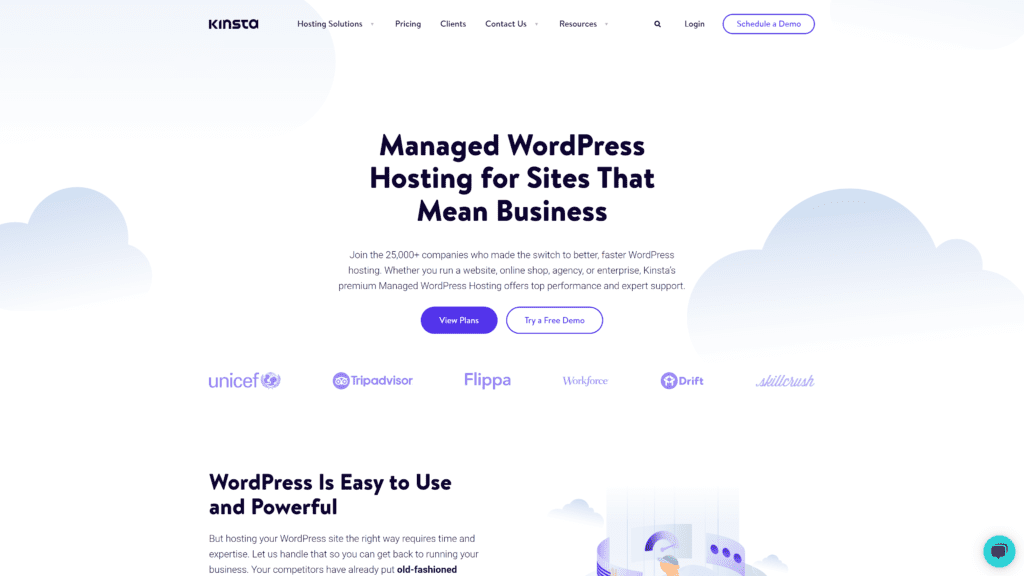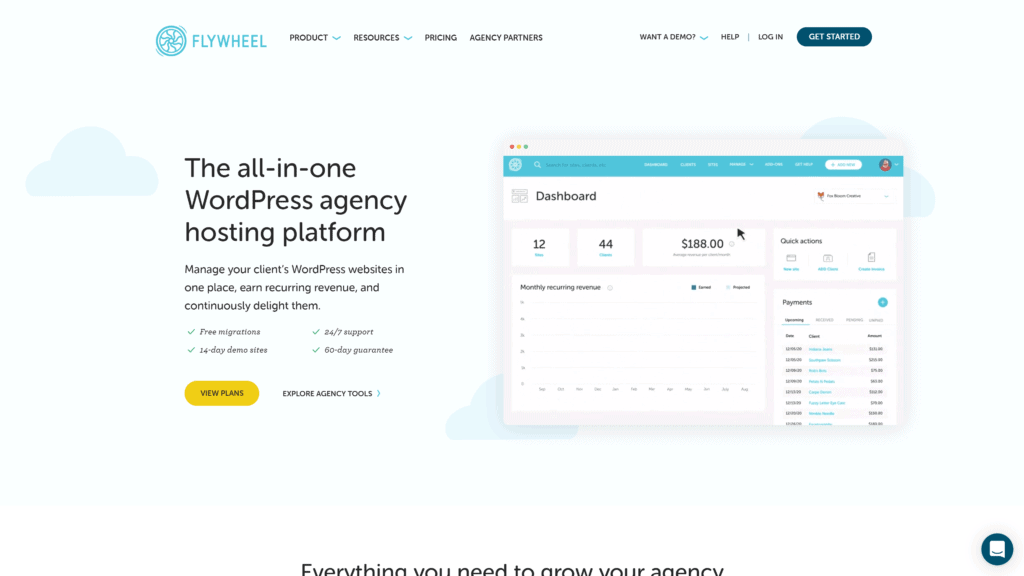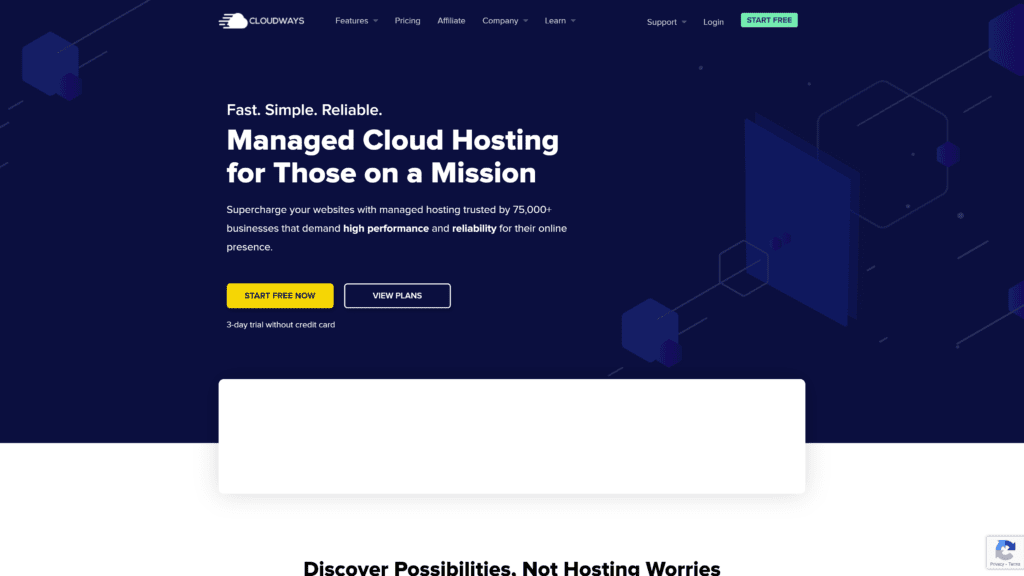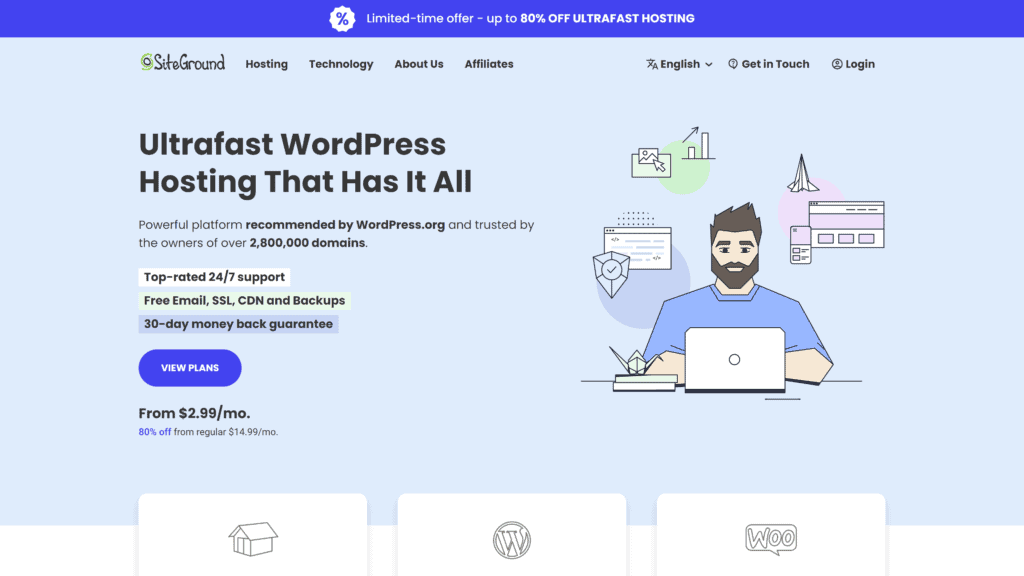Nowadays, building and maintaining a website doesn’t need to cost an arm and a leg or extensive coding knowledge.
With the right blog host provider, you can build a website even with limited technical skills.
Since blogging is popular now more than ever, more and more blog hosting providers are competing for your domain.
To help you choose, we’ve extensively tested some of the best blog hosting providers in 2023.
Let’s dive right in!
- What Is Blog Hosting?
- Do You Need a Hosting Site for a Blog?
- How Expensive Is It to Host a Blog?
- Features to Look for in Blog Hosting
- Don’t Get Distracted By
- Best Managed Blog Hosting for WordPress
- 1. Google Cloud – Best Overall
- 2. Kinsta – Runner-Up
- 3. WP Engine – Best for Small Businesses
- 4. Pressable – Best Value
- Founded in 2010, Pressable is a WooCommerce and WordPress-focused web hosting service that features NVMe servers, global CDN, and WordPress-oriented security. It’s owned and operated by Automattic, Inc., the same company that runs WordPress. As such, it’s perfectly optimized to run smoothly and safely on WordPress-based servers. Our Rating 4.5 / 5 Best For Freelancers, large businesses, and agencies thanks to unlimited plans. Notable Features NVMe Server: Pressable’s NVMe (Non-Volatile Memory Express) server dramatically increases a website’s response time as well as security. Perfectly optimized for WordPress: Pressable is owned and run by the developers of WordPress and WooCommerce, so it isn’t a surprise that it’s optimized to flawlessly run both services. Automatic failover: Pressable’s monitoring system automatically switches to an alternate server in the event that the website goes down. This way, you’re guaranteed 100% uptime no matter what happens. Pros Unlimited monthly data transfer: Regardless of which plan you choose, Pressable offers unlimited bandwidth across the board. This feature allows multiple visitors to access your site at its optimum speed without experiencing untimely crashes and drops. Powerful security: Pressable features an Intrusion Detection System that monitors network traffic for suspicious activity, a Secure Socket Layer (SSL) certificate, and Jetpack Security for improved site performance. Simple and intuitive interface: Pressable has an incredibly simple yet intuitive interface. It features a user-friendly dashboard and pre-installed plug-ins so it’s usable out of the box. It’s also super easy to create galleries, posts, and pages for your website. Cons Doesn’t feature instant auto-scaling: Pressable doesn’t support auto-scaling, so you’ll have to either upgrade or purchase add-ons as soon as your traffic shoots over the set limit. Lack of access to premium WordPress themes: Despite being managed by WordPress, you still have to pay for premium WordPress themes separately. Limited in-house backup system: Pressable doesn’t offer flexible in-house backup systems. You’ll need to contact customer service to do it for you. Is Pressable Hard to Use? Pressable is fairly simple to use. It’s easy to navigate and customize even without website-building knowledge. Plus, it has an extensive gallery of How-to’s and FAQs to help you manage your website. Pricing & Plans Pressable has eight pricing editions, depending on monthly visitors, local storage, and features. Entry to Personal: $19 – $25 1 website 5,000 to 30,000 monthly visitors 5 GB to 20 GB local storage Unlimited bandwidth Free SSL & CDN Starter: $45 3 website 50,000 monthly visitors 30 GB local storage Unlimited bandwidth Free SSL & CDN Pro to Premium: $90 to $155 10 to 20 websites 150,000 to 400,000 monthly visitors 50 GB to 80 local storage Unlimited bandwidth Free SSL & CDN Free site migrations Business (50, 80, 100): $350 to $675 50, 80, 100 websites respectively 1,000,000 to 2,000,000 monthly visitors 200 GB to 325 GB local storage Unlimited bandwidth Free SSL & CDN Free site migrations Free jetpack security Our Take Pressable offers great value to its customers. Alongside unlimited bandwidth across the board, it also features free SSL and CDN. You can get unlimited storage, website visits, and website installs for a reasonable price, which suits both newcomers and established businesses ranging from small to big. 5. Flywheel – Easiest to Carry
- Flywheel is a solid web hosting service that takes care of almost all the daily duties of running a website so you can focus on running your business. It was founded in 2012 and later bought by WP Engine in 2019, so it offers many of the same services but at a more affordable price. Our Rating 4.3 / 5 Best For New bloggers and small business owners for its eCommerce-based functions. Notable Features Blueprint: Flywheel’s Blueprint function allows you to build a new WordPress website without having to start from scratch. Staging sites on all plans: This feature allows you to make a copy of your live website so you can test any changes or add major features without breaking your site. Growth Suite client management: Flywheel’s Growth Suite feature allows you to keep track of your clients, visualize revenue insights and set-up invoicing in one personalized dashboard. Pros Incredibly fast performance: True to its name, Flywheel offers fast performance and near-perfect uptime with zero configuration. Top-notch security measures: Apart from basic features such as SSLs, this hosting blog offers malware removal, automatic backups, traffic monitoring and blocking, and limited login attempts. Intuitive development tools: Flywheel features multiple development tools, including Blueprints and staging environments. Blueprints reduce the need for manual installations, which staging environments make WordPress changes safer. Cons Offers limited email hosting: Flywheel’s default email functionality is extremely limited. You can only send and receive emails and reset your password. It’s so bareboned that even Flywheel recommends utilizing a 3rd party email host for more robust email functionality. Doesn’t offer access to third-party management tools: Since Flywheel has its own database management tool, it doesn’t allow access to other management tools like phpMyAdmin, SQL Developer, and Microsoft SQL Server. This can be a problem for users who’ve gotten used to a certain management tool for their website. Doesn’t sell domains: Flywheel doesn’t sell domains. If you’ve yet to create a site, you’ll first need to register your domain through a domain registrar before using Flywheel. Is Flywheel Hard to Use? Even with dozens of expert features, Flywheel is surprisingly easy to use. It has a beginner-friendly interface that’s as straightforward as can be. It offers WordPress migration upon sign-up, as well as a one-click WordPress installation. The installation will be ready to use immediately after you’ve registered. Pricing & Plans Flywheel has four plans: Tiny: $13 per month 1 website 5,000 monthly visitors 5 GB local storage 20 GB bandwidth Starter: $25 per month 1 website 25,000 monthly visitors 10 GB local storage 50 GB bandwidth Freelance: $96 per month 10 websites 100,000 monthly visitors 20 GB local storage 200 GB bandwidth Agency: $242 per month 30 websites 400,000 monthly visitors 50 GB local storage 500 GB bandwidth Our Take Flywheel is a fantastic website hosting service that exceeds expectations. Apart from email access, it ticks all the boxes in our web hosting checklist. It’s easy to use and navigate, and the interface is top-notch. 6. Cloudways – Best for Freelancers
- Best Cheap Blog Hosting for WordPress
- Conclusion
What Is Blog Hosting?
Blog hosting is a web hosting service that stores your blog’s data, files, and code while keeping them safe and secure. It comes in both free and payable options.
Free blog hosts provide a limited selection of templates and easy-to-use interfaces, making them suitable for personal use.
However, if you want to turn your blog into a source of supplemental income, it’s always wise to invest in paid blog hosting to maximize your profit and attract customers to your site.
Why is Blog Hosting Important?
A good host allows you to provide high-quality service to anyone who stumbles upon your blog.
It helps you generate leads or sell products, improve your SEO score, and protect your site from malicious threats and third-party attacks.
Do You Need a Hosting Site for a Blog?
You can open a blog without a hosting site, but it won’t be accessible to just anyone.
You need a hosting service to run a site intended for public access.
A hosting site protects and preserves your blog data and website code.
It provides you with unique server space for your website to live online without the fear of losing data or third-party access.
How Expensive Is It to Host a Blog?
Hosting a blog isn’t expensive at all. In fact, you can host a blog for free with some limitations.
If you’re serious about starting a blog, it’s worth investing a couple of dollars a month in a good blog hosting service.
You don’t even have to pay that much; you can find fantastic services for as low as $2.75.
That said, blog hosting can get expensive depending on your blog requirements.
For example, a host that supports over 75,000 monthly visitors and 125 GB bandwidth can easily touch the $100 mark.
Features to Look for in Blog Hosting
When subscribing to a blog host, consider the following functions and features:
1. Speed & Optimization Features
Your website’s speed affects your search engine ranking.
Slow performance is an immediate turn-off for customers, and lost traffic often means lost revenue.
As such, your blog host should have a bandwidth network of at least 20 GB and feature the latest optimization technologies like SSD (Solid State Drive) and global CDN (Content Delivery Network) for faster data access.
2. Uptime
When looking for a hosting service, make sure they offer excellent uptime at least 99.5% of the time.
You want the highest possible uptime scores to ensure your website remains functional even when you’re offline.
3. Ease of Use & Efficiency Features
Regardless of how tech-savvy you are, it’s always a good idea to opt for a hosting provider with an easy-to-use interface.
The hosting service should be intuitive, with simple navigation and one-click customization.
You certainly don’t want to spend ages setting up your account and potentially losing leads while doing so.
4. Email Account
Most hosts offer at least one email inbox connected to your domain so you can get in touch with your customers and supporters in a more professional capacity.
Search for a host that features multiple webmail services and formats, as well as autoresponders, archiving, mail forwarding, and the like.
5. Customer Support
Downtime and server errors are an inevitable part of running a website, especially if the website is still brand new.
For this reason, it’s important to choose a host that offers prompt, reliable, and experienced customer support to help you deal with any potential website issues along the way.
The website must have multiple ways of contact, including live chat, email, and call support if possible.
Don’t Get Distracted By
When looking for a blog hosting service, you’ll inevitably encounter options that may sound impressive at first, but later come with unfavorable consequences such as reduced performance, poor speed, and lackluster security.
Here are some instances you should avoid:
1. Free Domains
If you’re using your website as a temporary account that serves no other purpose apart from the occasional post, opting for a free domain probably isn’t a bad idea.
But if you intend to use your website to connect with people online and gain a following, avoid free domains.
Free domains don’t provide you with the proper tools to build a professional-looking site.
You’ll get limited bandwidth, infrequent backups, low-capped storage, and funky-looking URLs that people would think twice to click.
Avoid them at all costs.
But don’t worry, you can still get domains for as little as $1 through a number of providers.
2. Cheap Monthly Plans
The term “too good to be true” applies heavily here. If a hosting service offers a ton of amazing features at a suspiciously low price, you might want to look at the fine print.
Usually, cheap monthly plans come with several disadvantages, such as limited bandwidth and storage space, poor SEO, and security features that crack at a drop of a hat.
It’s better to go for a mid-priced hosting service to ensure the quality and safety of your website.
Here’s the thing with cheap shared hosting services: they limit your growth.
Cheap hosting services don’t have the capacity to handle multiple visitors at a time.
On top of that, they’re neither versatile nor flexible.
You won’t be able to customize your website to your liking with cheap plans.
Best Managed Blog Hosting for WordPress
Here are some of the best managed blog hosting sites you can use for WordPress:
1. Google Cloud – Best Overall

Google Cloud is more than just a blog hosting service; it’s a suite of cloud computing services that offers everything from data management to AI learning tools.
It hosts a variety of servers, including WordPress, LAMP stack on computer engines, Firebase, and Cloud Run.
Our Rating
4.7 / 5
Best For
Professional websites, agencies, and large businesses for its intuitive features.
Notable Features
- Extensive Global Network: Unsurprisingly, Google Cloud has one of the biggest global networks you can find. It has connections across 27 regions, 82 zones, and more than 200 countries—and counting.
- Partnerships with top companies: Google Cloud Platform partners with some of the world’s best tech companies to give you the best possible service across all fields.
- Open-source software: Google Cloud doesn’t limit user creativity. With the right source code, users can easily inspect, modify, and customize their websites. Google Cloud also makes it easy for you to move your website from one source to another instead of being stuck with one particular vendor.
Pros
- Access to uptime monitoring: Google Cloud lets you monitor the uptime of your website through the help of multiple resources, including AWS load balances, App Engine service, VM instance, and Kubernetes LoadBalancer Service among others.
- Unrivaled security: As one of the biggest companies in the world, Google knows just how important security is on a website. Google Cloud’s security uses the same protection services as some of its top products, including Gmail and Google Search.
- Highly reliable performance: Google has always been praised for its reliability, and that sentiment also rings true with Google Cloud. It has an uptime service-level agreement (SLA) of 99.99%, which is clearly documented in its terms and conditions. In the event of any downtime, Google offers decent financial compensation.
Is Google Cloud Hard to Use?
Google Cloud is pretty easy to use thanks to its dozens of click-to-deploy web hosting solutions.
These solutions simplify the setup and launching process, so you can focus more on your business rather than web building.
You get access to reliable customer support if you want to edit or add anything to your website, which makes web building even easier.
Pricing & Plans
Google Cloud operates on a pay-as-you-go basis, meaning that you’ll only pay for the services you use by the second.
This makes pricing a bit complex but overall cheaper than most plans, depending on what you use.
Pricing is divided into three basic web hosting plans: e2-micro, e2-small, and e2-medium.
e2-micro: from $6 per month ($0.008 hourly)
- 0.25 vCPU core; can be burst to 2 cores for 30 seconds
- 1 GB RAM
- 30 GB local storage
- 1 GB bandwidth
- 69 data centers, covering 200+ countries
e2-small: from $12 per month ($0.016 hourly)
- 0.5 vCPU core, can be burst to 2 cores for 60 seconds
- 2 GB RAM
- 1 GB bandwidth
- 69 data centers, covering 200+ countries
e2-medium: from $24.46 per month ($0.033 hourly)
- 1 vCPU core, can be burst up to 2 cores for 120 seconds
- 4 GB RAM
- 2 GB bandwidth
- 69 data centers, covering 200+ countries
Our Take
Google Cloud follows almost the same structure as other cloud services, but with better security and customization features.
Thanks to its state-of-the-art hosting configurations and extensive repository of self-service tools, it’s as reliable as a web hosting platform can get.
Plus, it’s quite a bit cheaper than other big-name hosting services as Google Cloud works on a pay-as-you-go basis.
2. Kinsta – Runner-Up

Kista is a premium WordPress-focused hosting service built atop of a Google Cloud platform. It’s fast, comprehensive, and packed with a ton of features. It’s quite pricey, though—the priciest on this list.
Our Rating
4.5 / 5
Best For
Large businesses due to its feature-rich plans.
Notable Features
- Near-perfect uptime: With Kinsta, server downtime rarely occurs. Even if it does, it doesn’t last longer than a few minutes. Kinsta offers compensation if your uptime rate drops below 99.99%.
- Speedy software: Kinsta uses inclusive software to maximize your server speed, such as PHP 7, MariaDB, Nginx, CDN, and others.
- Global Google Cloud data centers: Kinsta uses Google’s state-of-the-art servers to house its WordPress platform. This ensures you’re always getting the newest technology in the market as well as dozens of switchable server locations.
Pros
- Auto-scaling CPU and RAM: Kista automatically upscales your RAM and CPU in the event of sudden traffic or heavy project activity. The RAM Kinsta provides is estimated to be around five times more than what its competitors provide.
- Regularly optimizes its backups: Kinsta creates backups instantly, with no server overheads. It uploads a backup of your whole system rather than individual elements, allowing you to easily restore lost data with a single click.
- Solid security: Kinsta features numerous security tools to keep your site safe. Every account gets a free one-click SSL cert activation, round-the-clock monitoring, up to four name servers to set up DNS pointing, and automatic security updates.
Cons
- Steep price point: Kinsta’s insanely good features don’t come for free. The standard tier alone costs a whopping $35 a month, and it’s pretty lackluster compared to the other plans.
- No email hosting: For its price, we at least expected decent email hosting to be included in the plan. Unfortunately, this is not the case. You’ll have to subscribe to a separate service to get email hosting, making it an even bigger investment in the long run.
- Doesn’t run some plugins: Due to security and performance issues, Kinsta doesn’t allow some plugins. The list is quite extensive and features over 50 banned extensions, limiting their use on the platform.
Is Kinsta Hard to Use?
Kinsta is relatively easy to use. Upon activation, you’re greeted with a comprehensive panel and a wealth of resources to help both beginners and seasoned developers.
Migration is pretty simple, too—and free. All you need to do is to fill out the form and let the migration experts handle the process for you.
Pricing & Plans
Kinsta caters to a lot of website owners, with plans ranging from $35 to $1,650 per month. All plans come with free SSL, staging, CDN, and migrations. For this comparison, we’ve separated the plans into four categories:
Starter: $35
- 1 WordPress install
- 25,000 monthly visitors
- 10 GB local storage
Pro: $70
- 2 WordPress installs
- 50,000 monthly visitors
- 20 GB local storage
Business: $115 to $450
- 5 to 40 WordPress installs
- 100,000 to 600,0000 monthly visitors
- 30 to 60 GB local storage
Enterprise: $675 to $1,650
- 60 to 150 WordPress installs
- 1,000,000 to 2,500,000 monthly visitors
- 100 GB to 250 GB local storage
Our Take
Price point aside, Kinsta is a solid blog hosting option that excels in both speed and performance.
With its Cloudflare Enterprise infrastructure, user-friendly dashboard, and flexible staging pushes, Kinsta is hands-down one of the best hosting services there is.
3. WP Engine – Best for Small Businesses

WP Engine is a single-service WordPress hosting company.
Though it doesn’t offer anything outside WordPress hosting, it does feature some third-party tools like SSL from LetsEncrypt, CDN from Amazon, and CDN on CloudFlare’s network.
It’s a robust hosting platform with top-tier security, one-click restore points, and unlimited SFTP accounts.
Our Rating
4 / 5
Best For
Developers, small businesses, and experienced bloggers with some tech knowledge
Notable Features
- Fast loading time: WP Engine has a customized caching setup and a stacking service that’s more advanced than a typical web host. It also offers global CDN (Content Delivery Network) through MaxCDN, which boosts performance.
- Excellent uptime (100% in the past two years)
- Disaster recovery: WP Engine has built-in manual and automated backups to help you protect website data, so you won’t have to depend on third-party applications to do it for you.
Pros
- Proactive security: WP Engine works closely with top security firms to continuously monitor and update website security. It’s not only OC-2 compliant but also ISO 27001-2013 certified, meeting the safety requirements as laid out by the ISO.
- Easy-to-use workflow tools: WP Engine offers dozens of workflow tools to make your website as optimal as possible. This includes SSH access with MySQL, WP-CLI and bash, SFTP and GIT connections, WordPress-optimized WAF, and many others.
- Unlimited databases: WP Engine allows you to host unlimited domains, websites, and subdomains with a 50MB limit when importing a database. You can upload larger databases with the help of customer support.
Cons
- To reduce the risk of third-party attacks and maintain website speed, WP Engine has disallowed a number of external plugins. This includes some of the more popular ones such as Yet Another Related Post, CleanTalk, and LiveStats.
- Doesn’t register domain names: WP Engine is strictly a hosting service, so it doesn’t come with domain name registrations. You’ll have to register your domain on a separate website.
- Relatively costly: As mentioned earlier, WP doesn’t offer anything outside of blog hosting. This makes it a fairly pricey option, especially when compared to other hosting services on this list.
Is WP Engine Hard to Use?
WP Engine is easy to use out of the box, but setting it up to your liking can be a bit complicated.
You might have to contact customer service or go through the website’s knowledge base and FAQs to get the website running as you prefer it.
That said, everything you need—such as SSL and CDN, server-side caching, manual backup, etc.—is on a one-click basis and easily accessible.
Pricing & Plans
WP Engine comes in five basic plans: Startup, Professional, Growth, Scale, and Custom.
Startup: $20 per month
- 1 website
- Up to 25,000 monthly visitors
- 10 GB local storage
- 50 GB bandwidth
- Unlimited data transfer
Professional: $39 per month
- 3 websites
- Up to 75,000 monthly visitors
- 15 GB local storage
- 125 GB bandwidth
- Unlimited data transfer
- CDN included
Growth: $77 per month
- 10 websites
- Up to 100,000 monthly visitors
- 20 GB local storage
- 200 GB bandwidth
- Unlimited data transfer
- CDN included
- Up to 10 WordPress website installs
Scale: $193 per month
- 30 websites
- 400,000 monthly visitors
- 50 GB local storage
- 500 GB bandwidth
- Unlimited data transfer
- CDN included
- Up to 25 WordPress website installs
Custom (Prices depend on added features)
- 30+ websites
- 400,000+ monthly visitors
- 50+ GB local storage
- 500+ GB bandwidth
- Unlimited data transfer
- CDN included
- 25+ WordPress website installs
Our Take
WP Engine is a risk-free choice with intuitive functions.
Though a bit pricier than most, it’s reliable and comes with everything you need in a blog hosting service.
It’s got lots of WordPress-specific features, excellent page loading speed, and solid performance.
4. Pressable – Best Value



Cloudways is a managed cloud hosting platform that caters to eCommerce stores and business websites.
It configures servers with a hybrid “Apache + Nginx” stack, then layers it with caching such as Varnish, Nginx, and Varnish for improved performance.
Our Rating
4.2 / 5
Best For
Freelancers for its comprehensive security and eCommerce utilities.
Notable Features
- Enhanced security: Cloudway features industry-leading security certifications, 256-bit AES encryption, and independent verification of privacy, security, and compliance control.
- High bandwidth: Though Cloudways bandwidth isn’t unlimited, it may as well be because it offers at least 1TB bandwidth in all of its plans. Such high bandwidth allows you to add countless media elements to your website without having to worry about the limit.
- One-click WordPress hosting: WordPress hosting is mindlessly easy with Cloudways. With it, you get one-click backups, restores, and installation, built-in cache plugins, and free website migration.
Pros
- Uses customized caching system: Cloudways uses a PHP stack called ThunderStack, which offers maximum page uptime and load speed to all PHP applications.
- Pay-As-You-Go pricing: If you don’t want to opt for Cloudways’ monthly plans, you can instead subscribe to its hourly plans. This way, you’re not paying for server resources you’re not actually using.
- High-speed performance: Cloudways’ servers are incredibly fast, allowing you to deliver your site’s content to visitors immediately regardless of the traffic. It offers a whole host of dedicated speed-related features, such as PHP-ready servers, CDN, and auto-healing servers.
Cons
- Doesn’t offer free backups: Unlike the other services on this list, Cloudways doesn’t offer free backup. Instead, you’re charged per GB of storage used. You may want to periodically clean out old backups so you won’t have to pay too much on backing up your site data.
- No email hosting: Cloudways doesn’t have a free email function in its plans.
- No cPanel or Plesk: Cloudways doesn’t use traditional shared hosting services such as cPanel and Plesk. Instead, it uses a simple one-click dashboard.
Is Cloudways Hard to Use?
Cloudways isn’t hard to use. Nearly every feature is on a one-click basis, so you won’t have a lot of trouble managing the platform.
It’s extremely beginner-friendly, designed to make your life as easy as possible.
Pricing & Plans
Cloudways pricing starts from $10 a month, depending on the server resources you want and the cloud hosting provider (Digital Ocean, Vultr, AWS, Google Cloud, or Linode).
Standard: from $10 per month
- 1 GB RAM
- 1 core processor
- 25 GB local storage
- 1 TB bandwidth
Freelance: from $22 per month
- 2 GB RAM
- 1 core processor
- 50 GB local storage
- 2 TB bandwidth
Pro: from $42 per month
- 4 GB RAM
- 2 core processor
- 80 GB local storage
- 4 TB bandwidth
Business: from $80
- 8 GB RAM
- 4 core processor
- 160 GB local storage
- 5 TB bandwidth
Our Take
Cloudways is an affordable and reliable cloud hosting solution for any WordPress owner, regardless of site type, skill level, or expertise.
Since it’s a cloud-based platform, expect blazing fast server speeds, top-notch security, and optimal site performance.
Best Cheap Blog Hosting for WordPress
Here are some of the most affordable yet functional blog hosting services you can find today:
1. BlueHost – Best Budget Option

With over 2 million websites hosted and 500,000 domains registered, Bluehost is one of the biggest names in the service industry.
It’s founded in 2003 and has since evolved to become one of the largest suppliers of affordable web hosting worldwide, which is why it tops this list of “best cheap blog hosting” for WordPress.
Our Rating
4 / 5
Best For
Beginners and small business owners for its affordable pricing.
Notable Features
- Unlimited websites: BlueHost offers unlimited website installs in nearly all of their plans, allowing you to host and manage as many domains as you like in one place. You can find this option for as cheap as $5.45 a month, from the “Plus” tier.
- Custom themes: BlueHost offers dozens of customizable themes for your WordPress site. It doesn’t require any coding knowledge to customize the themes, and though it can take a bit of work, it isn’t all that tricky to pull off.
- Multiple hosting options: BlueHost offers an array of hosting options to suit your needs, including cloud hosting, shared hosting, VPS hosting, and dedicated servers. Each hosting option comes with its own unique functions and features, so it’s worth going through them individually to see which suits you best.
Pros
- Excellent uptime: for the past five years, BlueHost has kept a consistent uptime of between 99.96% to 99.99%, with the former happening only once in 2020.
- Staging sites for managed hosting plans: You can apply your settings to a duplicate website and only click “apply” when you’re happy with the changes you’ve made, minimizing downtime in the process.
- Integrated Cloudflare support: BlueHost offers free Cloudflare support across all its plans, which acts as a proxy between your visitors and your server.
Cons
- No automatic daily backup: Bluehost offers “complimentary” backups on a daily, weekly, and monthly basis, but these backups aren’t always guaranteed. As such, you’ll have to manually create and manage your own backup. Bluehost doesn’t take responsibility for lost or failed backups.
- Limited security features: Bluehost’s security features aren’t bad, but they’re fairly lackluster compared to other options. Domain privacy and spam protection—which is usually offered within the package by most web hosting services—costs an extra charge to add to the account.
- US-based servers: BlueHost’s servers are only available in the US. This isn’t too much of an issue if the majority of your customers live in America. But if you have international customers, you’ll have to install a CDN plugin to distribute your content across the world.
Is BlueHost Easy to Use?
Bluehost is one of the most beginner-friendly hosting companies in the industry.
Upon sign-up, WordPress is installed automatically so you don’t have to worry about doing so manually.
It also gives users access to easy-to-navigate control panels, as well as How-to articles, video tutorials, and detailed guides to help you with the web building process.
Pricing & Plans
BlueHost’s plans range from $9.99 to upwards of $200 a month, depending on the hosting plan you choose: Shared hosting, Dedicated hosting, WordPress-optimized hosting, WooCommerce hosting, and VPS.
For this comparison, we’ll list the pricing on BlueHost’s Shared hosting services.
Basic: $9.99
- 1 WordPress installs
- Free SSL (for the first year only)
- 15,000 monthly visitors
- 10 GB local storage
- Standard server performance
Plus: $14.99
- Unlimited WordPress installs
- Free SSL
- 50,000 monthly visitors
- 20 GB local storage
- Standard server performance
Choice Plus: $18.99
- Unlimited WordPress installs
- Free SSL
- 200,000 monthly visitors
- 40 GB local storage
- Standard server performance
Choice Pro: $28.99
- Unlimited WordPress installs
- Free SSL
- 400,000 monthly visitors
- 100 GB local storage
- High server performance
At the time of writing, BlueHost is offering up to 70% on its plans for new customers.
The cheapest plan—the Basic—costs around $2.95 with 70% off and the most expensive plan costs around $13.95 with 51% off for the first month.
Our Take
For its price, BlueHost offers a decent selection of features to help you build your website.
However, you may need to opt for additional add-ons or plugins to fully customize your website to your liking.
2. SiteGround – Best Extra Features

Founded in 2004, SiteGround hosts over 2.8 million domains worldwide.
It provides an array of hosting solutions, including cloud hosting, email hosting, enterprise solutions, and domain registration.
Our Rating
4 / 5
Best For
Freelancers, bloggers, and businesses for its flexible features.
Notable Features
- Free CDN: Regardless of the tier you’re subscribed to, SiteGround offers free access to global CDN to ensure the highest possible website speed.
- Powerful security: SiteGround uses multiple security tools to remove malware and secure you from third-party attacks. This includes smart firewall configuration, SSL certificate, AI-powered anti-bot filtering, and 24/7 active server monitoring among others.
- Small business-friendly: SiteGround improves WordPress development workflows in local environments through SSH access, SSL support, and shareable demo URLs.
Pros
- Reliable uptime: SiteGround has rock-solid stability and reliable uptime that doesn’t drop below 99.95%.
- Impressive security: Security is handled at the server level, so there’s no need to install security plugins. SiteGround can do a better job in protecting your site than any third-party software.
- Free daily backup: SiteGround backs up your website information on a daily basis, so you won’t have to worry about doing manual backups to save your data.
Cons
- No dedicated servers: SiteGround has many excellent hosting options, but it doesn’t offer any dedicated servers or even VPS. If your site gets a lot of traffic, you will not be able to upgrade to these higher-end options.
- Priority support for high-level plans only: SiteGround offers decent customer service, but it prioritizes its high-tier customers over its low-tier customers. You might not receive immediate support if you’re not subscribed to its higher plans.
Is SiteGround Hard to Use?
SiteGround is intuitive and easy to use.
The admin panel has everything you need in one convenient location.
You can install apps and plugins, as well as customize themes, with only a few clicks.
Pricing & Plans
Siteground’s plans are divided into three categories: Startup, GrowBig, and GoGeek.
Pricing depends on the plan and the period for which it’ll be prepaid, from one month to 36 months.
The longer the contract, the cheaper the plan.
Startup: $10.49 to $19.99 per month
- 1 WordPress install
- 10,000 monthly visitors
- 10 GB local storage
- 500 GB database
- 2 GB mailbox size
- Unlimited subdomains
GrowBig: $17.49 per month to $29.99 per month
- Unlimited WordPress installs
- 100,000 monthly visitors
- 20 GB local storage
- 750 GB database
- 4 GB mailbox size
- Ultrafast PHP
- Unlimited subdomains
GoGeek: $27.99 per month to $44.99 per month
- Unlimited WordPress installs
- 400,000 monthly visitors
- 40 GB local storage
- 1,000 GB database
- 6 GB mailbox size
- Ultrafast PHP
- Unlimited subdomains
Our Take
SiteGround is a good fit for any business, regardless of how big or small.
It’s a decently budget-friendly option that offers generous web space and plenty of functions and features to experiment with.
Conclusion
There you have it, folks; our list of the best blog hosting providers you can subscribe to today!
Our top choice for the best hosting service is Google Cloud for its cutting-edge technology and products.
The server provides faster transfer rates than standard SATA SSDs and SAS, which translates to better website performance overall.
Plus, it has connections across over 200 countries so you can use it optimally wherever you go!






